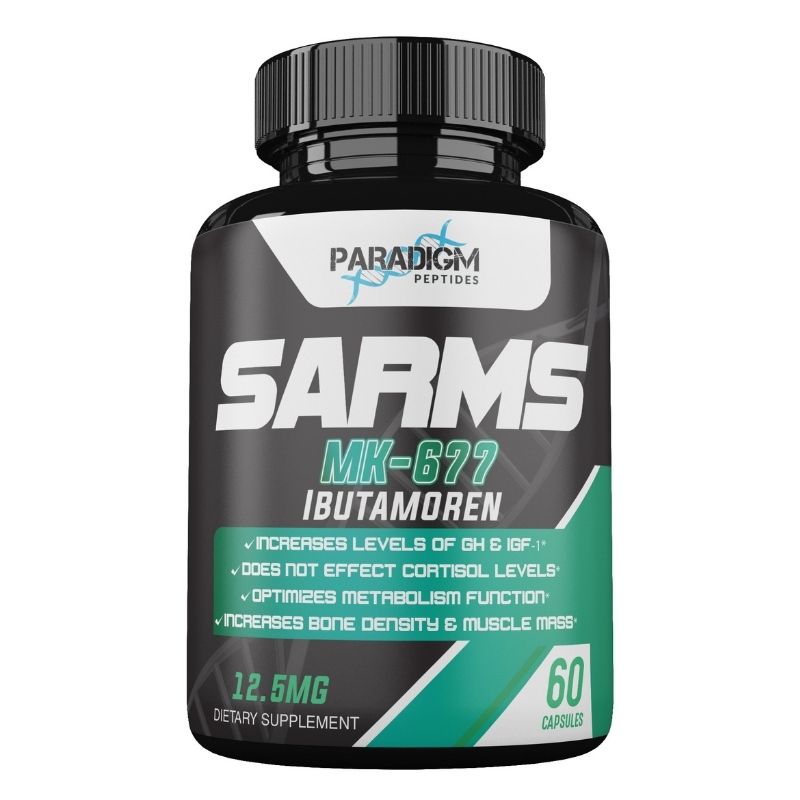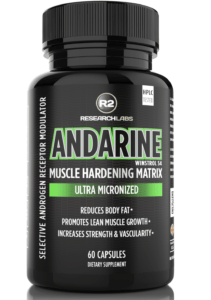You’ve probably seen the ads in muscle magazines: “Get huge without anabolic steroids!” They’re typically for dietary supplements called SARMS—short for selective androgen receptor modulators. We will be discussing everything that you need to know about SARMs or Selective Androgen Receptor Modulators.

What Are SARMs?
Selective Androgen Receptor Modulators (SARMs) are a type of drug that are designed to mimic the effects of testosterone in the body.
SARMs Are the Biggest New Muscle Drug – These Are the Facts
Though sold as a cutting-edge performance enhancer, these pills are unregulated. Here’s everything you need to know
Here’s what you need to know about SARMs
- SARMs are not approved by the FDA for human use. While some SARMs have been studied in clinical trials, they are not currently approved for use in humans. However, they are available for purchase online as dietary supplements or research chemicals.
- SARMs can have similar effects to anabolic steroids but with fewer side effects. SARMs have been touted as a safer alternative to anabolic steroids, which can have serious side effects like liver damage, hormonal imbalances, and acne. However, some research suggests that SARMs can still have negative effects on the body, such as reducing levels of good cholesterol and increasing the risk of heart disease.
- SARMs can be used to treat a variety of medical conditions. Some SARMs have shown promise in treating conditions like osteoporosis, muscle wasting, and hypogonadism (low testosterone). However, more research is needed to determine their safety and efficacy for these uses.
- SARMs are banned in many sports organizations. Because of their ability to enhance athletic performance, SARMs are banned by the World Anti-Doping Agency (WADA) and many other sports organizations. Athletes who test positive for SARMs can face suspension and other penalties.
- SARMs can have negative interactions with other drugs. Like any drug, SARMs can interact with other medications or supplements you are taking. It’s important to talk to your doctor before taking SARMs to make sure they won’t interact with any other medications you are taking.
What Do SARMs Do To The Body? Benefits of Using SARMs for Strength and Bulking
- They work by binding to androgen receptors in the body, which can stimulate muscle growth, improve bone density, and enhance athletic performance.
- SARMs might elevate your disposition and resolve.
- Strength and stamina will increase a feeling of optimism
- Your exercise capacity will increase significantly, as will your core strength.
- Significant gains in muscle growth and density will occur.
Side Effects of SARMs
One of the most common questions asked about SARMs is whether or not they cause side effects. While it is true that SARMs are not completely free of side effects and health risks, the vast majority of users report very little in the way of negative effects. In fact, the most commonly reported side effect of SARMS is mild nausea, which is typically only experienced by those who are taking high doses of the compounds.
There are some less common side effects, some that are potentially dangerous.
Some common side effects associated with SARMS
- Liver Damage
- Sexual Dysfunction
- Mood Swings
Overall, SARMS are much safer than traditional steroids and offer a much higher level of efficacy. As such, they have become increasingly popular among athletes and bodybuilders who are looking to improve their performance without putting their health at risk.
Different Types Of Sarms
The Top 5 SARMs for 2022
1. RAD140
RAD 140 helps to “dry” the body of excess fat and to muscle rebuilding, while MK-2866 strengthens bones to withstand the new weight resulting from the new muscle built. The combination of these two SARMs is a strength, energy, and endurance “bomb” to help you perform more intense and efficient workouts

- The SARM RAD140 is the substance that most closely resembles an anabolic androgenic steroid without really being one. Similar to most other SARMs, RAD140 is often used to treat osteoporosis and muscle wasting.
- However, it has been discovered to help cure low testosterone in more recent trials. putting it in the spotlight in the medical community as a possible substitute for steroids frequently used in testosterone replacement treatment.
- People who utilized RAD140 could have gained strength and muscle mass. Other favorable side effects that are advantageous to the fitness industry include increased testosterone and quicker fat burning.
2. Cardarine
Cardarine is a synthetic compound thought to boost metabolism and increase fat burning.

Cardarine SARMs have been shown to improve strength, power, and endurance while also reducing inflammation. In addition, Cardarine SARMs have been shown to improve fat loss while preserving muscle mass. Finally, Cardarine SARMs may also help treat conditions such as fibromyalgia and chronic fatigue syndrome.
- Another common SARM utilized by the fitness industry is cardarine, also known as GW-501516. It stimulates PPAR receptors.
- Different biological functions carried out by the body are controlled by these receptor types. It binds to these receptors, according to research, and then activates AMP-activated protein kinase. For you, what does that mean? These protein kinases, which control the body’s energy production, are what allow us to withstand times of metabolic stress.
- Cardarine can start a quick rise in fat loss and boost levels of energy output by activating these proteins.
3. MK677
MK-677 stimulates Growth Hormone and IGF-1 which each factor in significantly to maintaining lean body mass. Growth Hormone is believed by many to stimulate an increase in muscle size and strength and the ability of MK-677 to increase Growth Hormone production makes it a popular choice.

- Ibutamoren, nutrobal, and ibutamoren mesylate are only a few names for Mk-677. It functions as a growth hormone secretagogue and encourages the body to secrete natural growth hormones.
- Those who take MK677 frequently see both a gain in muscle growth and an increase in fat burn by increasing.
- It binds to ghrelin receptors to secrete. People who have used MK677 frequently mention increased muscular growth, comfortable sleep, improved emotions, and greater memory recall among other advantages.
4. Andarine
Andarine is an investigational selective androgen receptor modulator developed by GTX, Inc for the treatment of conditions such as muscle wasting, osteoporosis, and benign prostatic hypertrophy, using the nonsteroidal antiandrogen bicalutamide as a lead compound
Andarine attaches to proteins in the body known as androgen receptors. When andarine binds to these receptors, it tells the muscles and bones in the body to grow

- Andarine, another SARM created by GTx Pharmaceuticals, is primarily used as a therapy for osteoporosis and muscular atrophy. But it can also be used to treat other conditions, such as benign prostatic hypertrophy.
- Men and women can both utilize anadarine to promote healthy muscular growth. Due to its capacity to both stimulate quick muscle development and support the maintenance of lean muscle mass, the SARM for sale offers potential in the worlds of fitness and bodybuilding.
- Additionally, it can sustain muscular growth with continued usage.
- The next generation of supplements for building muscle is called SARMs, and they will gain popularity over time.
Which SARMs are safe?
Safest Sarms
RAD 140, MK 677, and LGD 4033 are considered 3 of the safest SARMs. The bodybuilding industry has adapted these PEDs one step further by removing the drug element and replacing them with natural ingredients. These hybrid ‘performance-enhancing drugs are called SARMs alternatives
Best SARMs For Strength: The Top 3
Your strength will increase as a result of all of the SARMs that grow muscle. However, how you utilize them is as important. You must make sure to concentrate equally on energy levels and mass while stacking SARMs. Instead of growing muscle, the goal is to increase your endurance so that you have a solid foundation.
● Cardarine, GW-501516
It’s a fantastic endurance builder that will enable you to improve your performance over several weeks. You’ll be able to exert more effort and move more quickly. Your strength will increase as a result, preparing you to do the bulking stack that will add muscle to the frame you have already built.
● SR-9009/9011
This operates differently than Cardarine, but it achieves the same result—it deceives the body into thinking it is producing more energy. It can help you increase your strength and endurance when used in combination with cardarine or in place of it.
● Ligandrol
This amazing androgenic SARM increased strength and massive muscle tone. But for now, it’s difficult to obtain. A suitable substitute is andarine, or you may try AC-262, which generates very comparable amounts of anabolic activity.
Is Sarms Legal?
- Are you aware of Selective Androgen Receptor Modulators (SARMs)—unapproved, illegal, and dangerous compounds found in performance-enhancing products?
- When used in dietary supplement products, sometimes with names like “ostarine” and “andarine,” they can pose a serious threat to consumer safety, particularly in the bodybuilding and fitness communities.
- SARMs have no business being marketed to consumers as dietary supplements.
- FDA has issued a warning about the dangers of products containing SARMs that are being marketed as dietary supplements.
- The World Anti-Doping Agency (WADA) has prohibited SARMs—these ingredients can cause professional and collegiate athletes to lose their eligibility.
- A new study in the Journal of the American Medical Association has identified the prevalence of SARMs in the online marketplace.
- They’re often marketed as dietary supplements—but don’t be fooled. They’re not legitimate dietary supplements, they’re unapproved drugs.
- And not only can they cause you to test positive for an illegal substance, but they can also do serious harm to your health when misused
SARMS Vs Steroids
Is SARMs A Steroid?
- Anabolic steroids are not SARMs. In essence, steroids are artificial hormones that function similarly to growth hormones and testosterone. They can help with muscle repair and muscle mass increase.
- The body’s androgen receptors, not only those in the muscles, will be impacted by them as well. SARMs are drugs that are exclusively meant to function in certain kinds of tissues. In other words, SARMs may theoretically increase the effective testosterone levels in muscle tissue while maintaining the levels in other parts of the body.
- Effective targeting can be used to cure illnesses and improve sports performance. There could be fewer adverse effects, such as alterations in temperament and function.
SARMs are still very much in the experimental phase, though. The FDA has not yet given its approval for usage.
SARMs Before and After Results
Sarms speed up the muscle-building potential meaning that you will get maximum gains within 2 months just like it takes a year for you without them.
Changes/results after the intake of SARM are mentioned below.
1. Weight/Fat loss
- Best SARMs for fat burning is amongst the top searches on Google and this is because SARMs are capable of incinerating the fat reservoir in the body.
- Not the healthy fat but the lipids that your body has been storing for years. In recent days, SARMs are more preferred over Clenbuterol a steroid that is used to get rid of extra fat in the body because of less risk associated with Andarine, one of the best SARMs for fat loss.
2. Highlighted Muscle Growth
- Most athletes and bodybuilders do take SARMs because they work like magic for outrageous muscle mass growth.
- Most of them expect to gain over 30 pounds of lean muscle which they achieved within 4 months time frame, but for this legit SARM supplement with proper prescribed dosage shall be taken into account.
- For example, regular use of 20mg of Ostarine considerably helps with muscle growth which has been experienced by thousands of bodybuilders in the US alone.
3. Escalated Stamina
- What is the use of SARMs if not for improved stamina and physical power?
- Nearly every SARM works on physical power and maximized strength which is the demand of every athlete and sportsman.
- Under the right dosage, SARMs not only amplify the stamina in men and women but also keeps them energetic, focused, and alert throughout the day.
4. Stops Muscle Wasting Syndrome
- Many bodybuilders working out with peak performance tend to lose healthy muscle tissues which aren’t supposed to be this way.
- This will also accumulate the water content in muscles which gives your arms and chest a flabby appearance.
- SARMs allocate the muscle and hydro content in a suitable way that will stop muscle wasting.
5. Faster and Superior Recovery against Muscle Fatigue
- Studies have shown that SARM’s long-term use makes the body endure pain and pressure efficiently.
- SARMs improve the energy production in muscles which also makes them resistant to sprains, injury, and fatigue during the workout or in the outside world.
Cycling SARMs
It is crucial that Ligandrol patients keep their cycles under 8 weeks. The SARM is not intended for long-term use since it might cause major health issues. Due to Ligandrol’s half-life of between 24 and 36 hours, just one daily injection is required
Prohormones Vs SARMs
SARMs are typically used to increase muscle mass and strength, while Prohormones are mainly used to increase muscle size and strength. Both can help with cutting cycles, with SARMs being slightly more effective due to their ability to target specific muscle groups
How Long Do Sarms Stay In Your System
Both SARMs are detectable in urine for approximately 2 weeks after a single dose of 60 mg of andarine and 30 mg of ostarine. Table 1. Tentative structure of andarine and ostarine metabolites and SRM transitions used for their detection. Position of glucuronide and sulfate may vary.
How To Take Sarms
- The best advice for how to take SARMs is through a capsule/tablet or liquid injection.
- Injections produce faster results because the SARM enters the bloodstream immediately.
- Stenabolic is often stacked together with other SARMs like Cardarine to maximize weight loss results
Peptides Vs Sarms
- SARMs are a popular non-steroidal supplement that athletes use to build their muscles.
- On the other hand, peptides are short amino acid sequences that athletes take as supplements for muscle building. Hence, this is the key difference between SARMs and peptides.
Sarms Goblin
Sarm goblins: teenagers that have an unreal amount of strength and abuse SARMs, great bodybuilding design for bodybuilders or weightlifters, for fitness enthusiasts and gym lovers for men women boys who are gigachads or aspiring giga chads
Bottom Line-SARMs or Selective Androgen Receptor Modulators
Overall, while SARMs have shown some promise in treating certain medical conditions and enhancing athletic performance, their safety, and efficacy are still being studied. It’s important to approach them with caution and to talk to a doctor before using them.
The views expressed are those of the sponsor/author and do not represent the stand and views of our Editorial.



